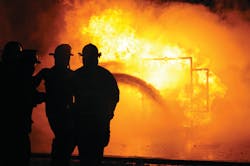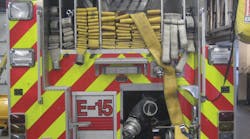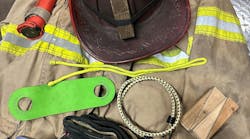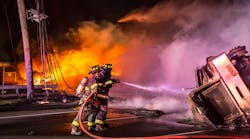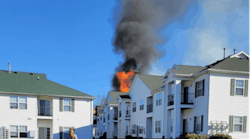The opening article in this series (Firehouse®, April 2013) introduced the idea that the success of the hoseline stretch is based on four phases – preparation, size-up, making the stretch and advancing the attack line to extinguish the fire. The purpose of this series is to reinforce the importance of knowing how properly stretch and operate attack hoselines. This month’s article presents an in-depth focus on phase one – preparation.
Preparation, the first and most important phase, starts with basic training, the beginning of one’s journey as a firefighter. This is where the foundation is laid for future success. In my fire service career, no other training has had such a major impact and influence as my basic training. My instructors were confident firefighters who integrated real fireground experience into the lessons they taught.
The fire service at that time (the 1980s) was still training people at a mastery skill level. We drilled on stretching and operating attack lines over and over to the point that I would go home and have dreams about hose coming off the engine. My basic training took place in a much simpler time, when the teaching focused on developing proficiency in basic firefighting disciplines. Today’s basic training, however, isn’t so basic, as the fire service is evolving to keep pace with the changing needs and threats with which society and our culture confront us. Add to that an economic climate that is forcing many fire departments to serve their communities with fewer firefighters and less funding than before. Many departments are forced to balance taking the time needed to adequately train rookie firefighters with pressure to put people on the street quickly and cheaply.
All of these factors have forced many departments to abandon training firefighters to a mastery skill level; instead, basic training is governed by a minimum standard that merely introduces firefighters to the concepts and skills of firefighting, which is to say they may not have to prove they are proficient at performing the skills. When firefighters graduate from basic training and report to a station or a company, it is the job of the officers and senior firefighters to complete their training and ensure they are proficient in performing basic firefighting skills – and that includes mastering the stretch.
OFFICERS’ TRAINING RESPONSIBILITIES
Set rookie firefighters up for success, not failure. Conduct an interview:
• Take the time to get to know them. You need to learn about their character and attitude.
• Provide clear expectations. Be transparent to establish trust and open communication.
• Get involved in their training by taking a hands-on approach.
Provide each firefighter with a journal to keep notes and track progress:
• Establish training goals and priorities. Have them keep a training log in the journal.
• Check the journals periodically and track their progress. The journals should be organized and neat.
• The journals will be a valuable resource throughout their careers. Make sure they take it seriously.
Establish a hands-off period. There is a tradition of hazing and playing practical jokes on rookies:
• You want each rookie to focus on the task at hand, not what prank is waiting around the corner.
• It will be your job to finish their training and ensure they can perform basic skills.
• Remind the rest of your crew it could be their life in the rookie’s hands, so take it seriously!
SENIOR FIREFIGHTERS’ RESPONSIBILITIES
Be a role model. Rookie firefighters are like sponges, soaking up all of your knowledge.
• They will be watching every move you make and doing everything you do.
• Remember that attitude and passion are contagious.
• Be humble and willing to share experiences and mistakes.
Coordinate training with the company officer to ensure consistency:
• Collaborate with the officer so you are aware of the goals and priorities that have been set.
• Involve the whole company to build teamwork.
• Report back to the officer regularly.
Teach, don’t preach. Demonstrate the skills; don’t just point and talk:
• Show the rookies how it’s done and set a benchmark for them to achieve.
• Be accessible to the rookies and never be too busy to help them or answer their questions.
• Challenge and test them to ensure they are absorbing and retaining the information.
• Most importantly, be patient. You didn’t learn it all overnight and neither will they.
Engine training
Now that everybody knows their roles, start your training at the rig. To master the art of firefighting and master the stretch, rookie firefighters must be intimately familiar with the engine they will be responding on. Have the rookies diagram the hosebed and the compartments on your engine, and then have them study it until they can tell you what is in every compartment before they open it. They should be going over the hoselines until they can describe each attack line in detail. If they cannot answer all nine of the following questions, they are not as prepared as they should be:
1. How many attack lines are there on the engine?
? Identify all options and choices available
? Which is the primary line and why?
1. What diameter of hose and what length?
? The diameter of the hose will determine the maximum flow
? The length of the line will help them make the right choice so they don’t stretch short
2. What type of nozzle; i.e., smooth bore/fog? This is important when choosing the best stream to extinguish the fire.
? Are you looking for penetration and reach? (Smooth bore)
? Or trying to generate steam? (Fog)
3. What’s the gpm setting or tip size? This information helps you make good fire-flow decisions.
? Are you using automatic nozzles with pre-set flows or are they adjustable gallonage?
? What are the gpm capabilities of the various-size smooth-bore tips?
4. Type of hose load; i.e., flat/minuteman/bundle load?
? How a particular attack line is loaded will determine the proper method to deploy it
? Is the hose load designed to be stretched by one or two firefighters
? Will the hose need to be inverted (nozzle on top/flat) or is the nozzle on the bottom (minuteman)?
5. Are the lines pre-connected or static? This has a lot to do with pre-planning your district.
? Is your district relatively predictable allowing a pre-determined length to be pre-connected?
? Or does your district present challenges that require the versatility of a static line?
6. Are they crosslays or do the lines come off the back step?
? How your engine is positioned at the scene of a fire will affect the decision on which line to stretch
? If you pulled past the structure, it will be more efficient to stretch off the rear (back step)
? If you stopped short, stretching off the side may be a more efficient option (crosslay)
7. What is your role when making the stretch?
? The success of the stretch is based on each member of the engine company knowing his or her job and responsibility
? Who will start the stretch? Who will assist with the stretch? Who calls for water in the line?
? A successful stretch doesn’t happen by luck or chance; you must have a plan
8. Does your department have a standard operating procedure (SOP) for stretching and operating attack lines?
? SOPs ensure a coordinated and safe effort on the fireground
? SOPs must be understood, followed and enforced
? SOPs should be trained on regularly
? SOPs eliminate freelancing and duplication of effort
Drill daily
You should be conducting drills on making the stretch every day. Demonstrate the correct techniques and skills, and then have the rookies perform them to your satisfaction. Take them step by step through the procedures and explain each step. You can start their training at the station, but get them out into your first-due district. Find vacant or unoccupied structures and have the rookies perform the stretch so they can experience firsthand the challenges they will face.
Another important part of preparation has to do with your knowledge of the structures and the district you respond in. Do you size-up the structures in your district when you are on calls other than fires? When you are investigating a gas or water leak or conducting inspections, are you taking mental notes of the floor plan, layout, number of bedrooms, egress points, etc.? Are you looking at the buildings around you trying to spot potential issues that may affect the stretch? The more knowledge you have about your first-due district and the structures you respond to, the easier it will be to anticipate potential challenges that will affect your ability to make an efficient stretch.
How often do you just get on the rig and drive through your first-due district? Pick a box, a street or a neighborhood and pre-plan your stretch. When teaching firefighters how to conduct a stretch estimate and determining distance, don’t focus on feet and inches, but rather on how many lengths of hose they would need to reach their destination. Talk about different ways to position the engine and discuss how the engine’s position will affect the stretch. Once you determine the most efficient position for the engine, have the rookies practice conducting a size-up and a stretch estimate. To make it more realistic, provide them with specific information such as location and extent of the fire within the structure.
When you least expect it
Whenever possible, have the rookies make a stretch when they not expecting it. Catch them off guard and see how well they do. At a recent call, we were dispatched for an odor of smoke in a building. The truck company investigated and found the odor was from a roofer who was sealing new roof seams with a torch. We determined there was no extension and I was about to clear the companies when I walked outside and saw a rookie firefighter “over-socializing” with the second-due engine crew.
I quickly got on my portable and called for a line to be stretched to the front door. The driver and senior firefighter knew what I was up to, but I took the rookie by surprise. He recovered nicely and hustled back to the engine. I’m happy to report they made a good stretch and learned a valuable lesson about always being prepared.
We must constantly challenge and better ourselves to obtain new information and knowledge. Even though rookies have graduated from basic fire training, their training is far from complete; in fact, it has only begun. We must regularly drill and train on stretching and operating attack lines to build and maintain the proper attitude and skills.
We must get out of the station and learn as much as we can about the buildings and the district we respond in.
For more about fire service training, visit: http://www.firehouse.com/topics/training.
